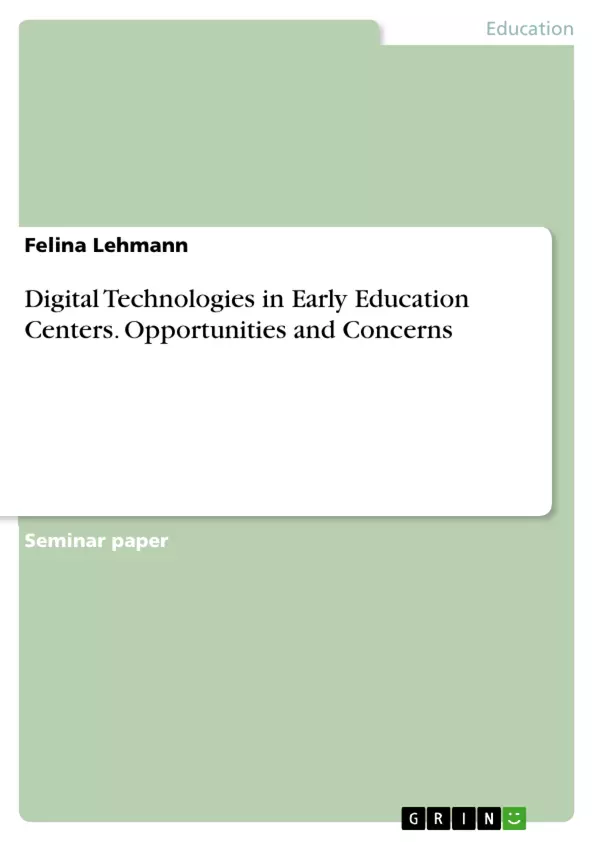In my paper I want to investigate the effects of rethinking early childhood education towards the use of digital technologies in order to find out what opportunities and chances arise from this change. In addition, possible concerns and challenges will be discussed in this regard.
I have structured my paper accordingly by starting with looking at the extent to which digitalization changes the required knowledge base by defining and thinking the concepts of Information Literacy and Technology Literacy together and highlighting essential skills in an interconnected world. After defining the term ICT in early childhood education, examples will be used to discuss how the implementation of digital technologies can look like regarding the work with parents, the work of the educators and the work with children. Following this, the opportunities, and chances to rethink and implement pedagogical approaches and to adapt the learning experiences to the 21st century which result from the implementation of ICT, will be discussed. After describing the opportunities, the concerns of digital resource use in day care centers will be further addressed, with a special focus on the challenges for the educator.
It should be noted that it is not possible to go into the opportunities and concerns in depth, as this would go beyond the scope of this paper, but rather the aim is to contrast the basic ideas about the main potentials and limits of digital technologies in early childhood education centers and to highlight the role of the educator.
Inhaltsverzeichnis (Table of Contents)
- Introduction
- Aim and Structure of the Paper
- A Changing World Requires a Transformation of the Knowledge Base
- The Concepts of Information Literacy and Technology Literacy
- The Four Cs: Essential Skills in an Interconnected World
- ICT in Early Childhood Education
- Opportunities and Potential of ICT - Innovate, Educate and Empower
- Transformative Learning Spaces: ICT as Driving Force for Change
- Digital Equality
- Meeting the Needs of All Learners
- Powerful Tools for Expanding Global and Cultural Awareness
- Educational Landscapes: Communication and Collaboration with Parents
- Motivation and Appreciation of the Educators
- Concerns and Challenges of ICT in Early Childhood Education
- Skepticism and Reservations
- Misplaced Focus and Increased Workload due to Constant Monitoring
- Key Challenge: The Educator's Role as Media Mentor
- Conclusion
Zielsetzung und Themenschwerpunkte (Objectives and Key Themes)
This paper aims to investigate the effects of rethinking early childhood education towards the use of digital technologies, exploring both the opportunities and challenges that arise from this shift. The main goal is to understand how incorporating digital tools into early childhood education can be beneficial and address the concerns that may arise. The paper focuses on:
- The changing knowledge base required in the digital age, with a focus on information literacy and technology literacy.
- The potential benefits of ICT implementation in early childhood education, including transforming learning spaces, promoting digital equality, meeting diverse learning needs, and expanding global and cultural awareness.
- The challenges of integrating digital technologies in early childhood education, such as skepticism, workload concerns, and the importance of the educator's role as a media mentor.
- The need to adapt pedagogical approaches and learning experiences to the 21st century in light of ICT integration.
- The importance of providing a balanced perspective on the opportunities and concerns surrounding the use of digital technologies in early childhood education centers.
Zusammenfassung der Kapitel (Chapter Summaries)
The introduction sets the scene by depicting a future where digital technologies are seamlessly integrated into early childhood education, highlighting the increasing prevalence of digital tools in modern learning environments. The paper then delves into the evolving landscape of knowledge and skills required in the digital age, emphasizing the shift from content-based learning to skills-based learning, particularly in areas like information literacy and technology literacy.
The chapter on opportunities and potential of ICT explores the transformative power of digital technologies in early childhood education, examining various aspects such as the creation of dynamic learning spaces, promoting digital equality, catering to diverse learning needs, and fostering global and cultural awareness. The paper highlights how ICT can facilitate communication and collaboration between parents, educators, and children.
The following chapter addresses the concerns and challenges associated with using digital technologies in early childhood education, such as skepticism towards technology, increased workloads due to constant monitoring, and the crucial role of the educator as a media mentor. It emphasizes the need for careful consideration and a balanced approach to integrating ICT in early childhood settings.
Schlüsselwörter (Keywords)
The paper focuses on the key concepts of digital transformation, information literacy, technology literacy, ICT in early childhood education, opportunities and challenges, digital equality, transformative learning spaces, media mentorship, and the changing landscape of knowledge and skills in the digital age. It explores the implications of these concepts for educators and children in early childhood education centers.
- Quote paper
- Felina Lehmann (Author), 2021, Digital Technologies in Early Education Centers. Opportunities and Concerns, Munich, GRIN Verlag, https://www.grin.com/document/1025587



